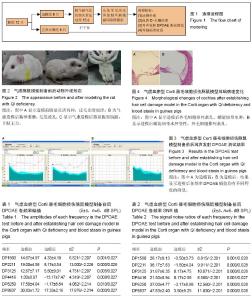| [1] 赵乌兰,王枫.金匮肾气丸对庆大霉素致聋豚鼠血清IL-2的影响[J]. 浙江中医杂志,2015,(9):647-648.
[2] 胡凌翔,吴皓,石复辛.内耳注射药物建立新生鼠耳聋动物模型[J].. 听力学及言语疾病杂志,2013,21(1):61-65.
[3] 汪银凤,王亚林,高炜.环磷酰胺对豚鼠自身免疫性感音神经性聋听功能的影响[J].中华耳科学杂志,2014,12(2): 328-330.
[4] 何景春,阮清伟,韩淼淼,等.应用顺铂建立C57小鼠感音神经性聋模型的实验研究[J]. 山东大学耳鼻喉眼学报, 2014,28(1):1-5.
[5] 闫辉,邢蔚,宋勇莉,等. 硫酸卡那霉素联合呋塞米快速致聋大鼠模型的研究[J].听力学及言语疾病杂志, 2014, 22(3):277-281.
[6] 石峰,李冬梅,杨锐睿,等. 内皮祖细胞在噪声性耳聋耳蜗损伤中的变化[J].中国医药导报,2015,12(31):30-34.
[7] 段宏,袁慧军. CRISPR/Cas靶向编辑技术系统与耳聋动物模型的建立[J].中华耳科学杂志,2015,13(1):171-175.
[8] 于文艳,李新.中西医结合治疗气虚血瘀型突发性耳聋66例[J].北京中医,2002,21(4):235-236.
[9] 彭桂原,李云英,杨黎,等. 金针联合药物治疗气虚血瘀证突发性耳聋36例临床观察[J].中医杂志,2015,56(23): 2036-2038.
[10] 于秀华,欧喜燕.人参花提取物对气虚血瘀模型大鼠血液流变学指标的影响[J].辽宁中医杂志,2012,39(10): 2071-2072.
[11] 朱传武,彭康,许文学.中风后遗症气虚血瘀大鼠模型能量代谢的研究[J].中医药学刊,2004,22(4):602-604.
[12] 杨硕,张艳,王思尹,等.参草通脉颗粒逆转慢性心衰气虚血瘀证大鼠模型疗效分析[J].辽宁中医药大学学报,2015, 17(5):50-53.
[13] 冯玄超,郭淑贞,武志黔,等.慢性心力衰竭模型大鼠气虚血瘀证相关信息的评价[J].中华中医药杂志, 2014,29(5): 1563-1567.
[14] 杨卫平,詹亚梅,邱德文,等.人参汤对实验性气虚血瘀证心肌缺血大鼠的血液流变学的影响[J].四川中医, 2005, 23(8): 26-27.
[15] 易亚乔,刘林,肖碧跃,等.血管性痴呆气虚血瘀证大鼠模型研究[J].中国中医药现代远程教育,2014,(9):152-153.
[16] 杨洪雁,张香东,崔梓扬,等.复合因素致气虚血瘀证模型的制备[J].中药药理与临床,2013,29(2):192-194.
[17] 王键,赵辉,李净,等.多因素复合制作气虚血瘀证脑缺血动物模型的实验研究[J].中国实验动物学报,2001,9(4): 216-220.
[18] 王净净,黄云峰,刘春华,等.眩晕定方对兔血管性眩晕气虚血瘀证模型血液流变学和脑血流图的影响[J].湖南中医药大学学报,2007,27(4):26-29.
[19] 成映霞,段永强,杨晓轶,等.NO/NOS和T-AOC/LPO在气虚血瘀型萎缩性胃炎中的表达及益气活血中药干预作用的研究[J].中医研究,2012,25(10):56-59.
[20] 李军兰,方肇勤.气虚证动物模型造模方法综述[J].上海中医药大学学报,2004,18(3):56-60.
[21] 樊慧杰,柴智,闫润红,等.补中益气汤对脾气虚证模型大鼠手术切口肌肉组织炎症反应和肉芽组织增生的影响[J].中医杂志,2014,55(3):238-241.
[22] 祝婧,钟凌云,龚千锋,等.升麻不同炮制品对脾气虚动物胃肠功能的影响[J].中国实验方剂学杂志,2015,21(21):1-4.
[23] 张学渊,汪吉宝.光化学法建立豚鼠耳蜗微循环障碍模型的初步报告[J].中华耳耳咽喉科杂志,1995,30(5): 285-288.
[24] 黄硕,张海林,张树泉,等.光化学法大鼠脑梗死模型的研究进展[J]. 中西医结合心脑血管病杂志,2015,13(5): 610-611,650.
[25] 李红戈,张茂悦,童萼塘,等.光化学诱导大鼠脑皮质梗塞模型的研究[J].卒中与神经疾病,1996,3(3):126-128.
[26] 卢宝全,尚小明,杨峰,等.应用手持激光器建立光化学法脑梗死动物模型[J].中国比较医学杂志, 2012,22(9): 63-67, 80,插4.
[27] 郝春华,王维亭,宋书辉,等.光化学法诱导大鼠冠状动脉血栓模型的建立和应用[J].中国药理学通报,2012,28(1): 143-146.
[28] 王熠钊,徐江,许涛,等.光化学法诱导猫不完全脊髓损伤动物模型的建立[J].中华物理医学与康复杂志,2010,(3): 161-165.
[29] 刘岩,张瑞帆,翁欢,等.光化学法诱导兔视网膜动脉阻塞模型的建立[J].复旦学报•医学版,2010,(1):106-109.
[30] 张文丽,李倩,郭静,等.重型颅脑创伤对大鼠耳蜗功能的影响[J].现代预防医学,2015,42(4):698-700.
[31] 王军义,邹志辉,陈晓滨,等. 噪声性听力损伤对豚鼠耳蜗Prestin蛋白及mRNA表达水平影响[J].中国职业医学, 2014,41(4):384-388.
[32] 卢保全,尚小明,杨峰,等.应用手持激光器建立光化学法脑梗死动物模型[J].中国比较医学杂志,2012,22(9):64-67.
[33] 李志勇,李彦文,王树荣,等.黄芪茯苓对药改善脾虚大鼠“脾主运化”功能的初步研究[J].时珍国医国药,2011, 22(6):1523-1524.
[34] 刘佳,郭文峰,任理,等.四君子汤对脾气虚证模型大鼠小肠葡萄糖吸收功能作用的影响[J].中国中西医结合杂志, 2013,33(10):1389-1393.
[35] 栾峰,张展翅,宋艳丽,等.缺血再灌注性耳聋与豚鼠畸变产物耳声发射的相关性研究[J].河北医药,2007,29(9): 931-932.
[36] 张纪帅,陈星睿,吴军,等. 白噪声暴露前后豚鼠听觉功能的检测[J].中华耳科学杂志,2015,13(1):141-144.
[37] 黄秋红,黄子真,郑亿庆,等.一种新型中耳炎小鼠模型在耳鼻咽喉科的应用[J].中国耳鼻咽喉头颈外科,2013, 20(11): 569-572.
[38] 王晓花,胡家庆,王艳军,等. 慢性航海疲劳复合因素对大鼠听觉功能的影响[J].中华航海医学与高气压医学杂志, 2013,(6):369-371.
[39] 张雪茹,赵立东,邢光前,等. 听神经病动物模型造模方法[J]. 中华耳科学杂志,2012,10(3):400-404.
[40] 吴玮,韩浩伦,王方园,等. 习服后风洞噪声相关听力损失易感性及其耳蜗超微结构变化[J].中华耳科学杂志, 2013,11(2):288-292. |

